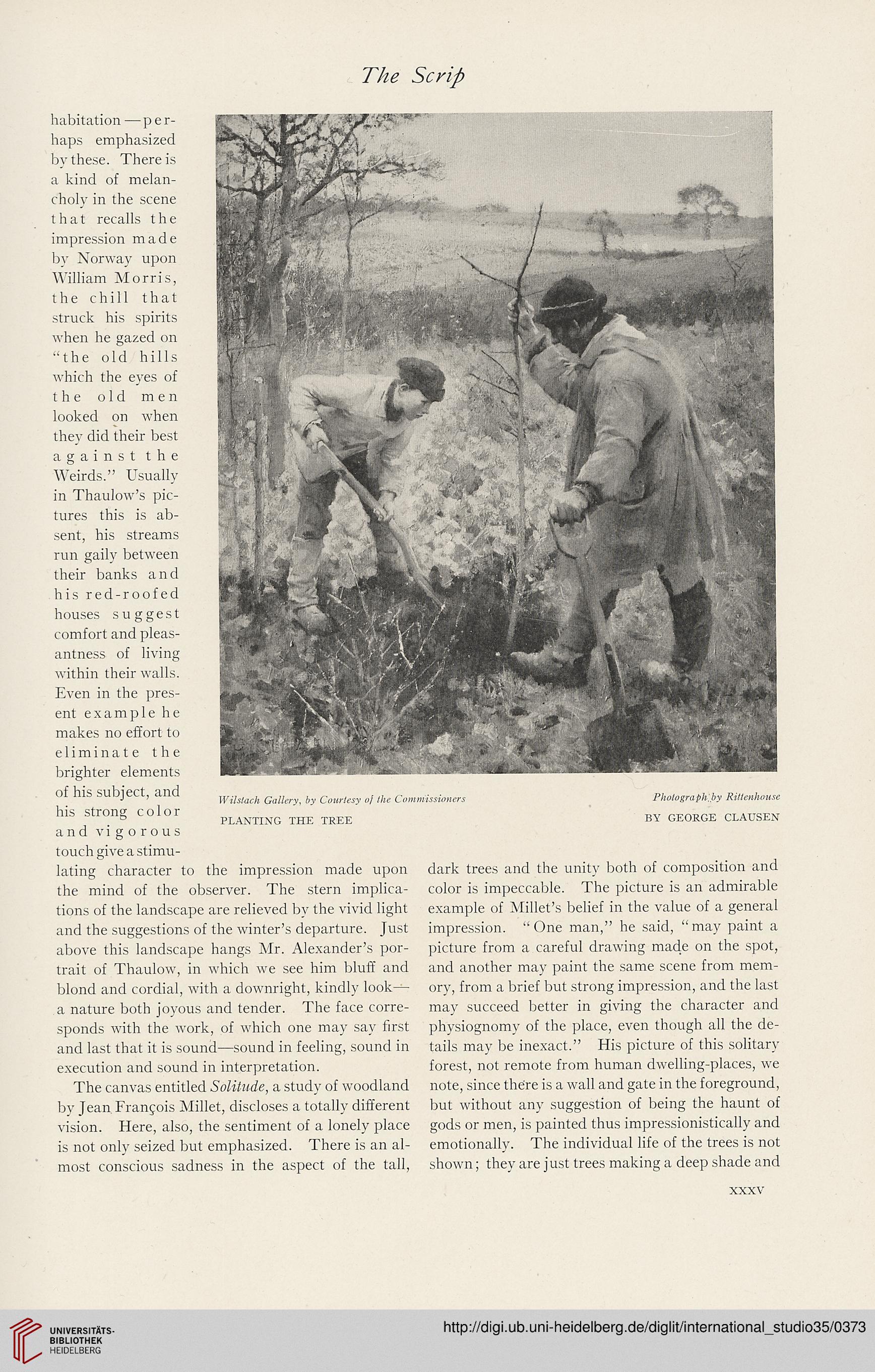The Scrip
habitation — p e r-
haps emphasized
by these. There is
a kind of melan-
choly in the scene
that recalls the
impression made
by Norway upon
William Morris,
the chill that
struck his spirits
when he gazed on
“the old hills
which the eyes of
the old men
looked on when
they did their best
against the
Weirds.” Usually
in Thaulow’s pic-
tures this is ab-
sent, his streams
run gaily between
their banks and
his red-roofed
houses suggest
comfort and pleas-
antness of living
within their walls.
Even in the pres-
ent example he
makes no effort to
eliminate the
brighter elements
of his subject, and
his strong color
and vigorous
touch give a stimu-
lating character to the impression made upon
the mind of the observer. The stern implica-
tions of the landscape are relieved by the vivid light
and the suggestions of the winter’s departure. Just
above this landscape hangs Mr. Alexander’s por-
trait of Thaulow, in which we see him bluff and
blond and cordial, with a downright, kindly look—
a nature both joyous and tender. The face corre-
sponds with the work, of which one may say first
and last that it is sound—sound in feeling, sound in
execution and sound in interpretation.
The canvas entitled Solitude, a study of woodland
by Jean Franjois Millet, discloses a totally different
vision. Here, also, the sentiment of a lonely place
is not only seized but emphasized. There is an al-
most conscious sadness in the aspect of the tall,
Wilstach Gallery, by Courtesy of the Commissioners
PLANTING THE TREE
Photograph'by Rittenhouse
BY GEORGE CLAUSEN
dark trees and the unity both of composition and
color is impeccable. The picture is an admirable
example of Millet’s belief in the value of a general
impression. “One man,” he said, “may paint a
picture from a careful drawing made on the spot,
and another may paint the same scene from mem-
ory, from a brief but strong impression, and the last
may succeed better in giving the character and
physiognomy of the place, even though all the de-
tails may be inexact.” His picture of this solitary
forest, not remote from human dwelling-places, we
note, since there is a wall and gate in the foreground,
but without any suggestion of being the haunt of
gods or men, is painted thus impressionistically and
emotionally. The individual life of the trees is not
shown; they are just trees making a deep shade and
XXXV
habitation — p e r-
haps emphasized
by these. There is
a kind of melan-
choly in the scene
that recalls the
impression made
by Norway upon
William Morris,
the chill that
struck his spirits
when he gazed on
“the old hills
which the eyes of
the old men
looked on when
they did their best
against the
Weirds.” Usually
in Thaulow’s pic-
tures this is ab-
sent, his streams
run gaily between
their banks and
his red-roofed
houses suggest
comfort and pleas-
antness of living
within their walls.
Even in the pres-
ent example he
makes no effort to
eliminate the
brighter elements
of his subject, and
his strong color
and vigorous
touch give a stimu-
lating character to the impression made upon
the mind of the observer. The stern implica-
tions of the landscape are relieved by the vivid light
and the suggestions of the winter’s departure. Just
above this landscape hangs Mr. Alexander’s por-
trait of Thaulow, in which we see him bluff and
blond and cordial, with a downright, kindly look—
a nature both joyous and tender. The face corre-
sponds with the work, of which one may say first
and last that it is sound—sound in feeling, sound in
execution and sound in interpretation.
The canvas entitled Solitude, a study of woodland
by Jean Franjois Millet, discloses a totally different
vision. Here, also, the sentiment of a lonely place
is not only seized but emphasized. There is an al-
most conscious sadness in the aspect of the tall,
Wilstach Gallery, by Courtesy of the Commissioners
PLANTING THE TREE
Photograph'by Rittenhouse
BY GEORGE CLAUSEN
dark trees and the unity both of composition and
color is impeccable. The picture is an admirable
example of Millet’s belief in the value of a general
impression. “One man,” he said, “may paint a
picture from a careful drawing made on the spot,
and another may paint the same scene from mem-
ory, from a brief but strong impression, and the last
may succeed better in giving the character and
physiognomy of the place, even though all the de-
tails may be inexact.” His picture of this solitary
forest, not remote from human dwelling-places, we
note, since there is a wall and gate in the foreground,
but without any suggestion of being the haunt of
gods or men, is painted thus impressionistically and
emotionally. The individual life of the trees is not
shown; they are just trees making a deep shade and
XXXV





